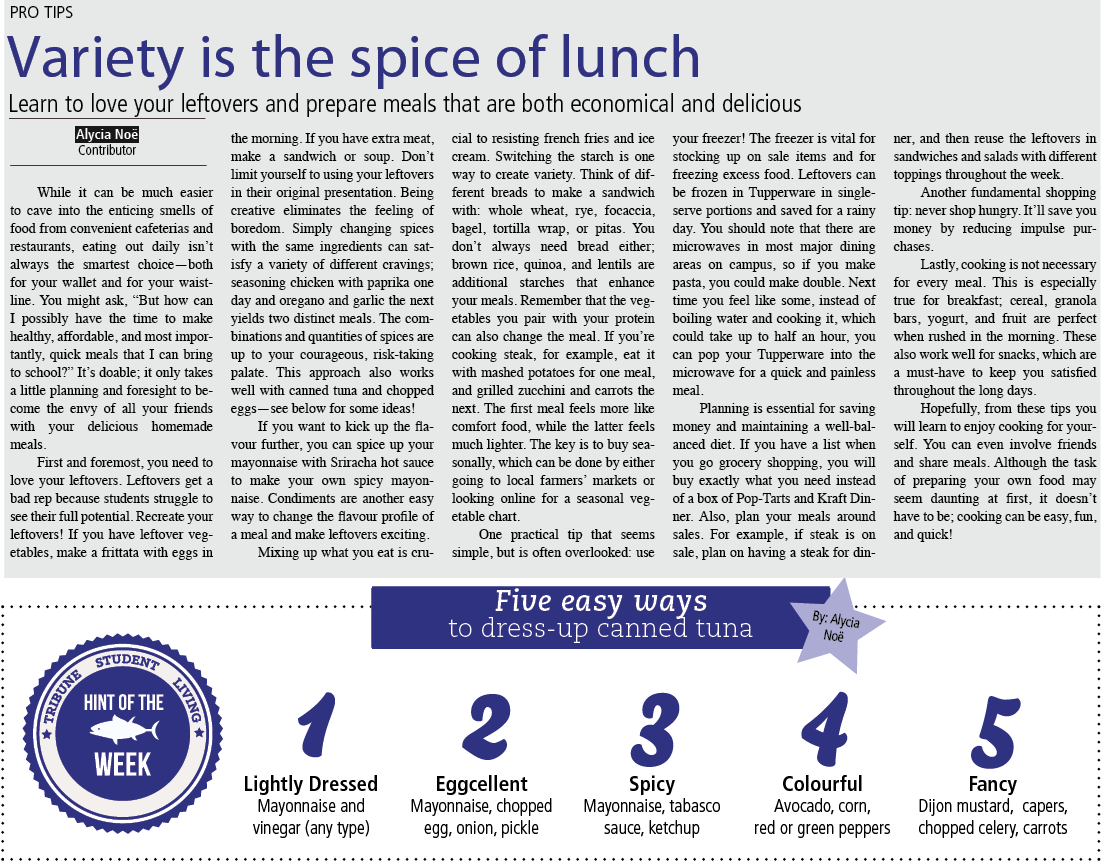While it can be much easier to cave into the enticing smells of food from convenient cafeterias and restaurants, eating out daily isn’t always the smartest choice—both for your wallet and for your waistline. You might ask, “But how can I possibly have the time to make healthy, affordable, and most importantly, quick meals that I can bring to school?” It’s doable; it only takes a little planning and foresight to become the envy of all your friends with your delicious homemade meals.
First and foremost, you need to love your leftovers. Leftovers get a bad rep because students struggle to see their full potential. Recreate your leftovers! If you have leftover vegetables, make a frittata with eggs in the morning. If you have extra meat, make a sandwich or soup. Don’t limit yourself to using your leftovers in their original presentation. Being creative eliminates the feeling of boredom. Simply changing spices with the same ingredients can satisfy a variety of different cravings; seasoning chicken with paprika one day and oregano and garlic the next yields two distinct meals. The combinations and quantities of spices are up to your courageous, risk-taking palate. This approach also works well with canned tuna and chopped eggs—see below for some ideas!
If you want to kick up the flavour further, you can spice up your mayonnaise with Sriracha hot sauce to make your own spicy mayonnaise. Condiments are another easy way to change the flavour profile of a meal and make leftovers exciting.
Mixing up what you eat is crucial to resisting french fries and ice cream. Switching the starch is one way to create variety. Think of different breads to make a sandwich with: whole wheat, rye, focaccia, bagel, tortilla wrap, or pitas. You don’t always need bread either; brown rice, quinoa, and lentils are additional starches that enhance your meals. Remember that the vegetables you pair with your protein can also change the meal. If you’re cooking steak, for example, eat it with mashed potatoes for one meal, and grilled zucchini and carrots the next. The first meal feels more like comfort food, while the latter feels much lighter. The key is to buy seasonally, which can be done by either going to local farmers’ markets or looking online for a seasonal vegetable chart.
One practical tip that seems simple, but is often overlooked: use your freezer! The freezer is vital for stocking up on sale items and for freezing excess food. Leftovers can be frozen in Tupperware in single-serve portions and saved for a rainy day. You should note that there are microwaves in most major dining areas on campus, so if you make pasta, you could make double. Next time you feel like some, instead of boiling water and cooking it, which could take up to half an hour, you can pop your Tupperware into the microwave for a quick and painless meal.
Planning is essential for saving money and maintaining a well-balanced diet. If you have a list when you go grocery shopping, you will buy exactly what you need instead of a box of Pop-Tarts and Kraft Dinner. Also, plan your meals around sales. For example, if steak is on sale, plan on having a steak for dinner, and then reuse the leftovers in sandwiches and salads with different toppings throughout the week.
Another fundamental shopping tip: never shop hungry. It’ll save you money by reducing impulse purchases.
Lastly, cooking is not necessary for every meal. This is especially true for breakfast; cereal, granola bars, yogurt, and fruit are perfect when rushed in the morning. These also work well for snacks, which are a must-have to keep you satisfied throughout the long days.
Hopefully, from these tips you will learn to enjoy cooking for yourself. You can even involve friends and share meals. Although the task of preparing your own food may seem daunting at first, it doesn’t have to be; cooking can be easy, fun, and quick!








